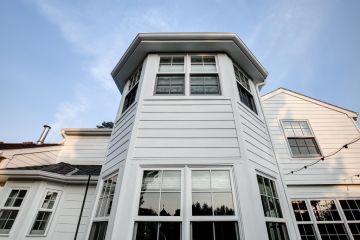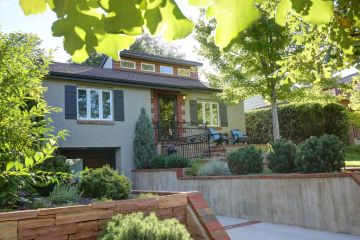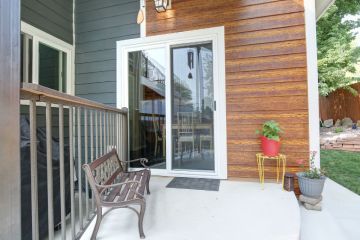At Bellwether, though we don’t build walls, we have complete knowledge of framing and wall construction so that we can protect these structures with our siding. Siding, or wall cladding, is the protective material attached to the exterior walls of a house or other building. Siding materials drive your home’s appearance and style, but siding is also a necessary, functional element of your home’s construction and efficiency.
When we talk about home siding, there are many elements of structure and design that, together, result in a beautiful, functional, and protected home. But there are underlying pieces of your home siding system that ensure this protective, long-lasting quality. At Bellwether, we understand that what’s underneath is just as important as the siding you see, and we are committed to solid craftsmanship from bottom to top.
Studs and Framing
Studs and framing make up your home’s wall structure. Studs, which create the vertical framework behind the wall, serve several purposes, including carrying the weight of the floor or roof above and directing that weight toward the foundation; and serving as a necessary layer to which plywood or sheathing is attached. Today, the stud spacing and paneling are standardized. In places where you cannot have studs, like doors and windows, horizontal beams, called headers, carry the load and span the opening.
Sheathing (OSB Wood Panels)
The sheathing is what gives the stud wall its rigidity and usually consists of OSB (oriented strand board) or plywood paneling. These panels are fastened to the studs. In older homes, sheathing was often constructed from boards; in newer homes, some sheathing is made from rigid foam or steel traps. Regardless of the material, sheathing is designed to prevent the walls from collapsing along the studs.
Underlayment
Underlayment or weather-resistive barrier (WRB) is installed between the siding and the sheathing. This can be tar paper or a house wrap, such as HardieWrap® or Tyvek HomeWrap®. HardieWrap® is great for keeping out water while simultaneously allowing water vapor to escape away from the home, allowing breathability and protecting against mold and water damage.
Insulation
Insulation keeps the cold outside and allows you to better regulate your home’s interior temperature. Insulation also plays a big role in your energy efficiency. Good insulation can drastically lower your utility bill while creating a comfortable environment inside your home. Insulation can easily be replaced and can be a cost-effective way of updating and upgrading your home. Bellwether installs spray foam as well as fiberglass batt insulation.
Flashing
Flashing is another layer of water-resistant material that guides water away from your home. It is a thin but impervious layer of protection that prevents water from seeping into the home interior and instead directs the flow of water away from the house walls.
Inside Surface
More often than not, your home’s interior walls are covered with drywall or plaster for a finished look. If the exterior elements of your siding are built from high-quality materials and are professionally, and properly installed, your interior walls should remain protected and high-functioning. Though many interior walls are not load-bearing, it is important to confirm before removing the wall. Interior walls with drywall and plaster can, however, be easily repaired.
Trim
Trim can refer to both an exterior and an interior design element in a home. On the exterior, a trim usually finishes around windows and doors, as well as the fascia board and the soffits along the roof. While this enhances a home’s design, it does aid in the weather-protection functions, serving as another moisture-prevention layer that can be installed to direct water away from windows and doors. Interior trim kind of trim is also both decorative and practical, adding a high-design finish to windows and doors inside, and contributing to the sealing around these spaces. Baseboard trim covers gaps between the wall and the floor to add a finished look to the wall.
Paint
Paint is the last layer of a wall and can be added in any color. Paint covers the wall space for a truly finished look, and it can have an incredible impact on a home’s design, both inside and out. Paint options are an easy way to add creativity and personality to your home.
Contact Bellwether today to receive a hassle-free quote for your next exterior remodeling project.
What’s Under My Siding FAQs
What are the eight layers beneath my exterior home siding?
Much goes into a wall beneath the home siding, including studs and framing, sheathing (OSB panels), underlayment, insulation, flashing, interior surface, trim, and paint.
Why is it important to know what’s underneath my siding?
The systems that make up the walls of your home should all work together to create a sturdy structure, efficient energy and temperature control, protection for the home, inside and out, and a beautiful design that you feel proud of. Bellwether believes each component of the wall structure should meet a high standard in both materials and installation so that you can count on your walls to do all of these things.
Under Your Siding: What is Bellwether’s Moisture Management System?
We guarantee that our siding installations include an expertly designed moisture management system. Bellwether-installed siding creates a barrier between the living spaces of your home and the outside environment, to keep your home comfortable and dry. A professional moisture management system beneath your siding includes flashing, moisture barriers, drainage holes, and careful caulking to seal against rainwater and other elements.














